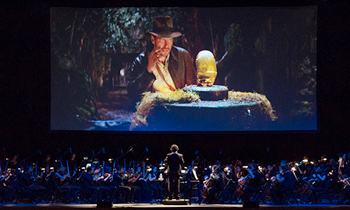by Timothy Robson

The film was projected both on a very large screen suspended above the Orchestra on the stage and on two large digital video screens hung from the outer rim of the pavilion. Associate conductor Brett Mitchell led The Cleveland Orchestra in John Williams’s Oscar-nominated score. A bevy of technicians made it all work, mixing and managing the various elements of the show, including the spoken dialogue and special effects. The precision of the coordination was remarkable, leading to the somewhat ironic conclusion that The Cleveland Orchestra — at full force on Saturday — did not intrude in a splendid screening of Raiders of the Lost Ark.
The plot, with its many unexpected twists and turns, involves the search for the legendary Ark of the Covenant by the Nazis in Egypt in 1936, wanting it for Hitler’s unspecified purposes. Indiana Jones and buddies proceed with their own search using conveniently obtained evidence of its location from a medallion given to Marion by her late father, Indy’s mentor. Many life-threatening situations ensue, with a final showdown after the Nazis steal the Ark from Indy. The Nazis open the Ark, and a catastrophe worthy of an Old Testament prophecy kills the Nazis and other associated bad guys, while Indy and Marion are miraculously saved. The power of U.S. governmental bureaucracy ultimately prevails, and the Ark is sealed and stored in an undisclosed location forever.
John Williams began composing film scores in the late 1950s, and by 1981 he had become the “go-to” composer for directors George Lucas and Steven Spielberg, having already won three Oscars for his film work, including Spielberg’s Jaws and Lucas’s Star Wars. Williams received numerous other nominations and Grammy awards, including a nomination for Raiders of the Lost Ark.
The score is symphonic in scope, underscoring most of the film, except for a few extended passages of dialogue. Williams is a genius who can completely change character with one or two chords as the film cuts from one scene to the next. Themes for the characters and situations are developed with Wagnerian clarity, and the orchestral writing is virtuosic throughout. And unlike the original recording by the London Symphony Orchestra, The Cleveland Orchestra played the entire score non-stop. It likely contained more music — if perhaps less profound — than a Mahler or Bruckner symphony, and Brett Mitchell kept the whole thing moving. After some tweaking of the dialogue levels, the sound mix in the pavilion was clear and full.
The screening included an interpolated intermission not found in the theatrical release of the film. An orchestral entr’acte preceded the “second act,” presumably extracted from somewhere in the score.
The climactic scene in which the wrath of God is sent down on the movie’s bad guys after they open the Ark of the Covenant was harrowing in its orchestral garb. The visuals themselves are not particularly spooky (and seem to have been used to much greater effect for the Death Eaters in the Harry Potter films), but the orchestral score more than compensates to create a cataclysmic scene.
Because of the constant need to stay in sync, this event did not allow Brett Mitchell much opportunity to interpret the score, but in the end The Cleveland Orchestra played their role magnificently in bringing Steven Spielberg’s movie masterpiece to life.
Published on ClevelandClassical.com September 6, 2016.
Click here for a printable copy of this article.



